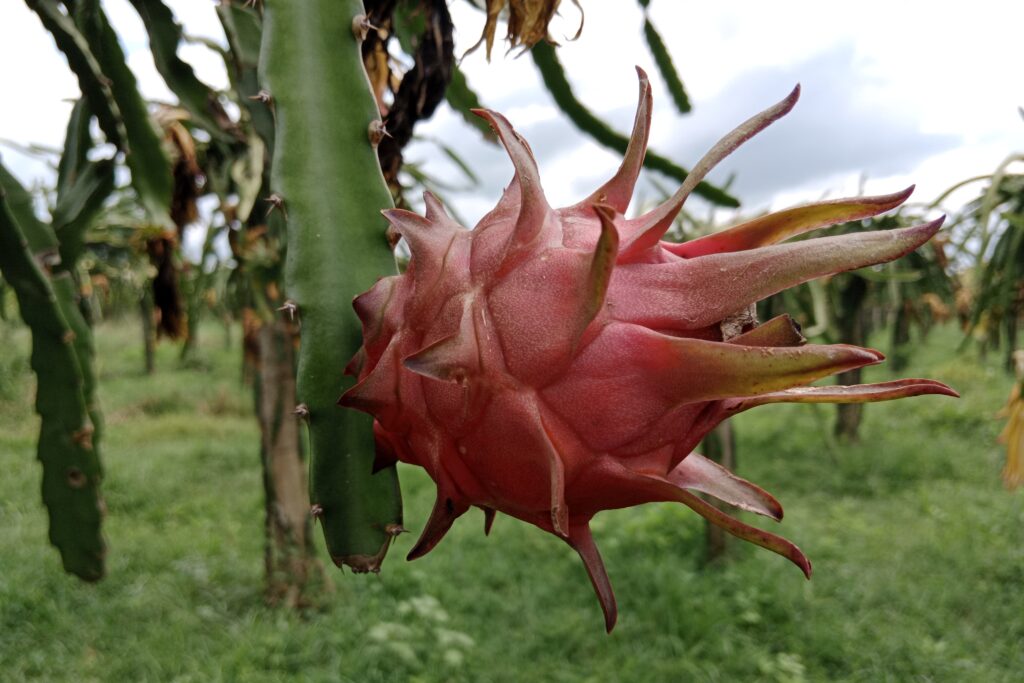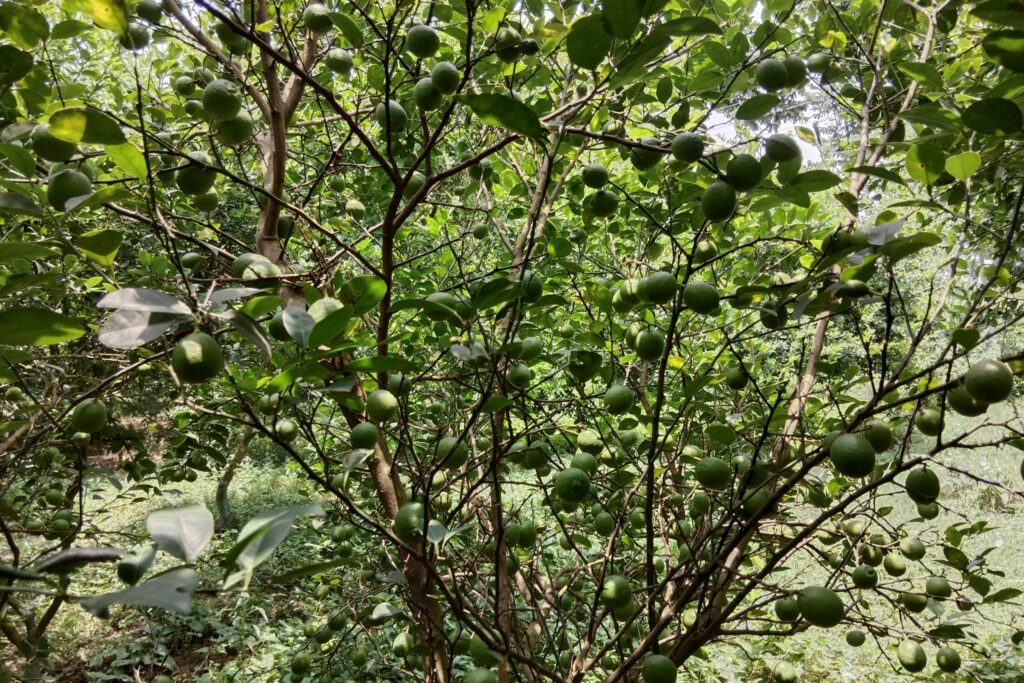Raspberry Farming
Raspberries are a nutrient-dense fruit, rich in dietary fiber and vitamin C, and their antioxidant properties may contribute to reducing the risk of chronic diseases such as heart disease, diabetes, and inflammation. The analysis of raspberry farming profit per acre highlights that summer-bearing raspberries yield a total income of NRs. 6,800,000 over 10 years, with a net profit of NRs. 5,152,000 after deducting initial costs of NRs. 523,000 and maintenance expenses of NRs. 1,125,000.
In contrast, everbearing raspberries generate NRs. 11,200,000 in total income, resulting in a higher net profit of NRs. 9,228,300 after accounting for an initial investment of NRs. 846,700 and similar maintenance costs. Summer-bearing raspberries break even by year 3, while everbearing achieve this milestone in year 2 due to earlier income generation. Over a decade, everbearing offers 79% higher profitability, but both varieties yield an annual income of NRs. 400,000 post-year 10.
Everbearing is ideal for those seeking quicker returns with a higher initial investment, whereas summer bearing suits those preferring lower initial costs. Combining both varieties can optimize cash flow and minimize risks.
Land Preparation
In order to build a clean foundation, the area must be cleared of weeds, shrubs, and debris. Deep plowing is then used to loosen the soil, improve root penetration, and improve drainage and aeration. The field is leveled after plowing to guarantee even water distribution, and raised beds or rows are set up to promote appropriate drainage, especially in areas that frequently get high rainfall. The best soil conditions for raspberry growth are guaranteed by this methodical technique.
Soil Type
Raspberries thrive in well-drained, loamy soil rich in organic matter, with a slightly acidic pH ideally between 5.5 and 6.5 (or 6.5–6.7 for optimal growth). Soil pH adjustments can be made using lime for acidic soil or sulfur for alkaline soils, and testing with readily available kits ensures precision. Good drainage is critical to prevent root rot, particularly in wet winters, and raised beds are recommended to enhance drainage in poorly draining or shallow/chalky soils. Moisture-retentive yet aerated soil balances hydration and root health, avoiding waterlogged conditions that harm raspberry plants.
Climatic Requirements
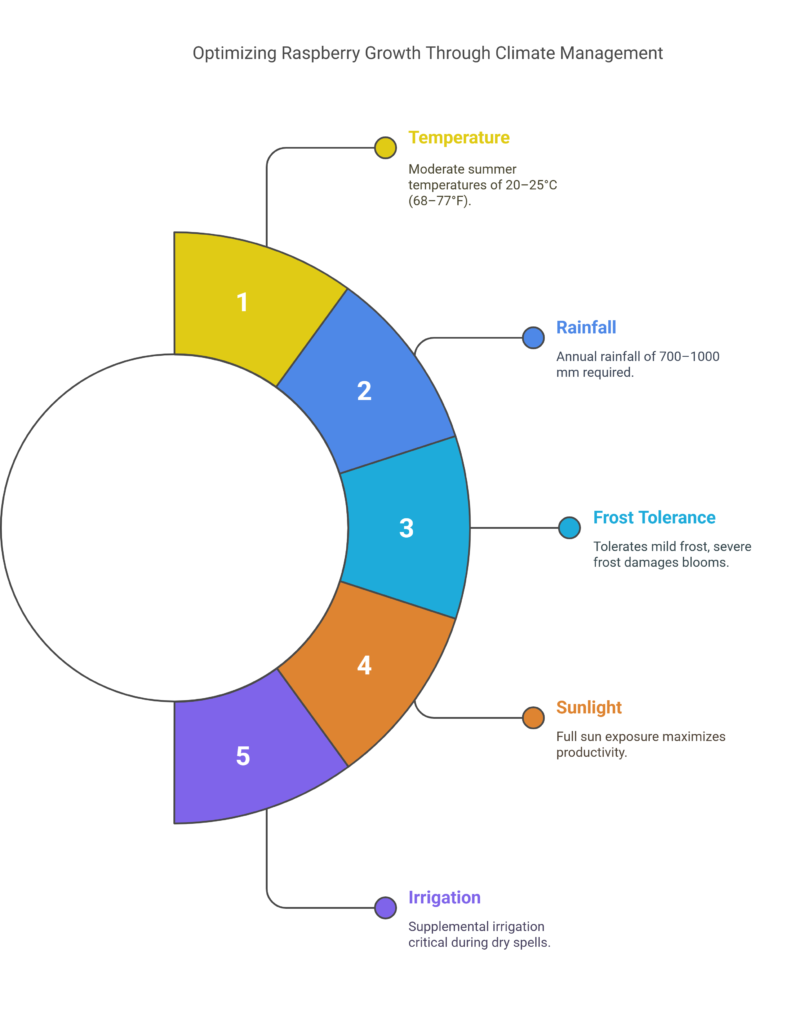
Raspberries thrive in temperate climates with moderate summer temperatures of 20–25°C (68–77°F) and require 700–1000 mm of annual rainfall, though supplemental irrigation is critical during dry spells to sustain growth. While most cultivars tolerate mild frost, severe frost during flowering can damage blooms and reduce yields. Full sun exposure is ideal for maximizing productivity, but in regions with intense heat, partial shade helps mitigate stress. Proper climate management ensures a balance of warmth, moisture, and sunlight to support healthy growth and fruit development.
Major Cultivars
a). Summer-Bearing
Summer-fruiting raspberries are vigorous growers, typically reaching heights of around 1.8 meters (6 feet) and forming large, bushy plants. These varieties produce fruit from early to late summer, depending on the specific type. When newly planted, they generally begin fruiting in their second year, making them a slightly longer-term investment for gardeners. Heritage, Tulameen, Meeker (produce fruit in summer), Royalty, Brandiwine, Black Hawk, Bristol.
b). Everbearing/Primocane
On the other hand, autumn-fruiting raspberries tend to be more compact, growing to about 1.2 to 1.5 meters (4 to 5 feet) tall. These varieties bear fruit from late summer into the autumn season and are well-suited to smaller gardens due to their manageable size. Unlike summer types, they usually produce fruit in their first year, offering quicker results and easier pruning. Fallgold, Autumn Bliss, Polka (bear fruit on first-year canes).
Planting
In order to avoid shade, raspberries are typically cultivated in rows, preferably from north to south. Additionally, a protected location is better because strong winds can break thin fruiting side branches and discourage pollinating insects.

a). Planting Season
Begin with healthy, one-year-old raspberry canes sourced from a trusted nursery, ideally planted in early spring when the soil is workable. In regions with mild winters, late autumn planting is another option, allowing for early root establishment. Container-grown plants offer versatility and can be planted throughout the growing season, while dormant bare-root canes are best planted in late winter or early spring before new growth emerges. Proper planting timing reduces transplant stress, supports optimal root development, and fosters rapid growth and productivity.
b). Spacing
i). Summer bearing
Summer-fruiting varieties, being more vigorous, may require slightly wider spacing to accommodate their bushy growth. Proper spacing ensures good airflow, sunlight penetration, and ease of maintenance, reducing disease risks and promoting healthy yields.
Plant to plant spacing: 3 feet.
Row to row spacing: 3 meters.
ii). Everbearing / Autum bearing
Autumn-fruiting types can tolerate tighter spacing.
Plant to plant spacing: 2 feet.
Row to row spacing: 2 meters.
c). Pit Preparation
For pit preparation, dig holes measuring 30 cm in width and depth, then blend the excavated topsoil with organic manure—such as compost or well-rotted farmyard manure—to enrich the planting medium. This nutrient-rich mixture is backfilled into the pits to create a fertile base, ensuring robust root development and sustained nourishment for raspberry plants. Proper pit preparation enhances soil structure, moisture retention, and long-term plant health.
d). Planting Method
To prevent exposing roots or burying the root collar, plant raspberry canes at the same depth as when they were developed in the nursery. In order to remove air pockets and guarantee that roots stay in contact with the soil, backfill the pits with the prepared soil-manure combination, gently compacting the soil around the plant. By simulating natural growing circumstances, this technique encourages stability, lessens transplant shock, and facilitates successful establishment.
e). Number of Plants per Acre
Plant density varies between raspberry types: 1,482 plants per acre are recommended for summer-bearing varieties, while everbearing cultivars require a higher density of 3,317 plants per acre to maximize yield and accommodate their growth habits. This difference accounts for everbearing raspberries’ extended fruiting season and need for tighter spacing to optimize light exposure and airflow. Adhering to these guidelines ensures efficient resource use, balanced competition, and alignment with pruning and maintenance practices for each type.
Intercropping
Intercropping with short-duration vegetables like lettuce, spinach, or radish during the first two years of raspberry cultivation can optimize land use and provide supplemental income, while avoiding plants such as tomatoes or potatoes that share pests (e.g., verticillium wilt, aphids) common to raspberries. This practice minimizes pest risks, reduces weed competition, and ensures resources like nutrients and sunlight are prioritized for young raspberry plants, promoting healthier establishment without compromising long-term yields. Careful crop selection balances soil health and economic efficiency in the early growth stages.
Irrigation
Raspberries require weekly irrigation to maintain consistently moist soil without waterlogging, ideally using drip irrigation for efficient water use and minimizing disease risks associated with overhead watering. During critical growth stages like flowering and fruiting, ensure sufficient water supply to support bud development and fruit quality, adjusting frequency based on rainfall and soil conditions. Proper moisture management balances root health and productivity, preventing stress that could reduce yields or damage plants.
Fertilizer and Manure
Growing raspberries require balanced nutrient management. To enhance soil structure and enrich organic matter, add 10–20 tons of farmyard manure per acre to the soil prior to planting. In order to promote root development, flowering, and fruit quality, annual fertilization consists of 50–70 kg of nitrogen per acre, divided into two doses (early spring and post-fruiting), as well as 30–40 kg/acre of potassium (K₂O) and phosphorus (P₂O₅) applied at the beginning of the growing season. If soil testing show shortages, micronutrients such as magnesium and boron should be added to ensure healthy development and resistance to nutrient-related diseases. For long-term production, this program strikes a balance between the distribution of macronutrients and organic inputs.
Weed Control
Effective weed control in raspberry cultivation involves regular manual weeding or hoeing to eliminate competition for nutrients, water, and sunlight, particularly during early growth stages. Applying organic mulch (e.g., straw, wood chips, or black plastic) suppresses weed germination, retains soil moisture, and moderates soil temperature, while minimizing reliance on chemicals. For persistent or large-scale weed challenges, selective herbicides approved under local agricultural guidelines can be used cautiously to target weeds without harming raspberry plants. Integrating these strategies ensures a weed-free environment, reduces labor costs, and promotes robust plant health and yield.
Pest and Disease Management
Major Pests
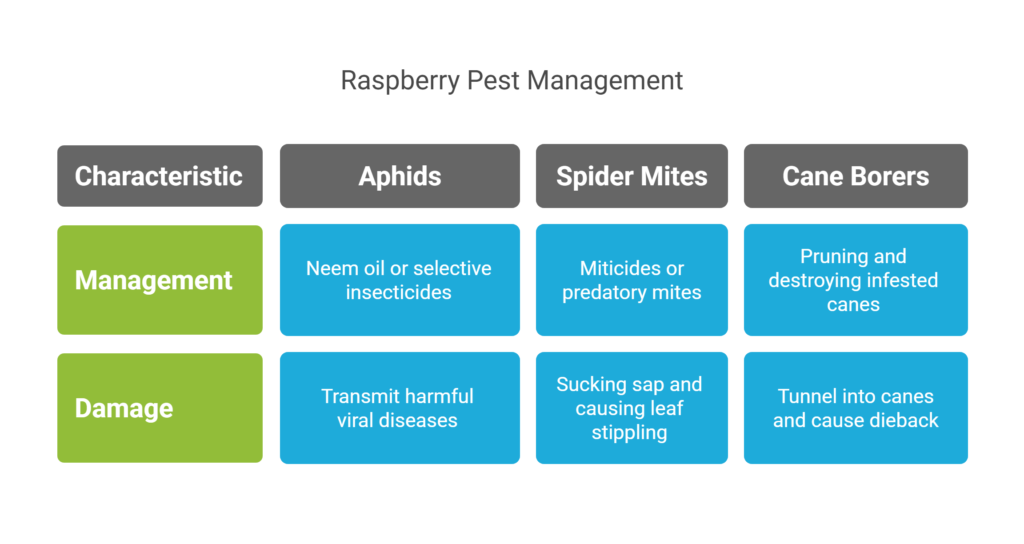
a). Aphids
Aphids, which transmit harmful viral diseases to raspberry plants, can be managed through timely intervention using neem oil (an organic solution) or selective insecticides to minimize infestations. Regular monitoring and early application disrupt their life cycle, reducing viral spread and protecting plant health while balancing ecological impact.
b). Spider Mites
Spider mites, which weaken raspberry plants by sucking sap and causing leaf stippling, can be controlled by spraying miticides (acaricides) or introducing predatory mites (e.g., Phytoseiulus persimilis) for biological control. Early detection and treatment prevent population explosions, preserving leaf health and photosynthetic efficiency while minimizing chemical use. Integrated approaches balance effectiveness with ecological sustainability.
c). Cane Borers
Cane borers, which tunnel into raspberry canes and cause dieback or plant weakening, are managed by promptly pruning and destroying infested canes to eliminate larvae and halt their lifecycle. Remove affected canes during the dormant season or at first signs of damage (e.g., wilted tips, entry holes), and burn or dispose of them away from the field to prevent reinfestation. This cultural control method reduces reliance on pesticides, preserves plant vigor, and disrupts the pest’s habitat, ensuring healthier growth and sustained yields.
Common Diseases
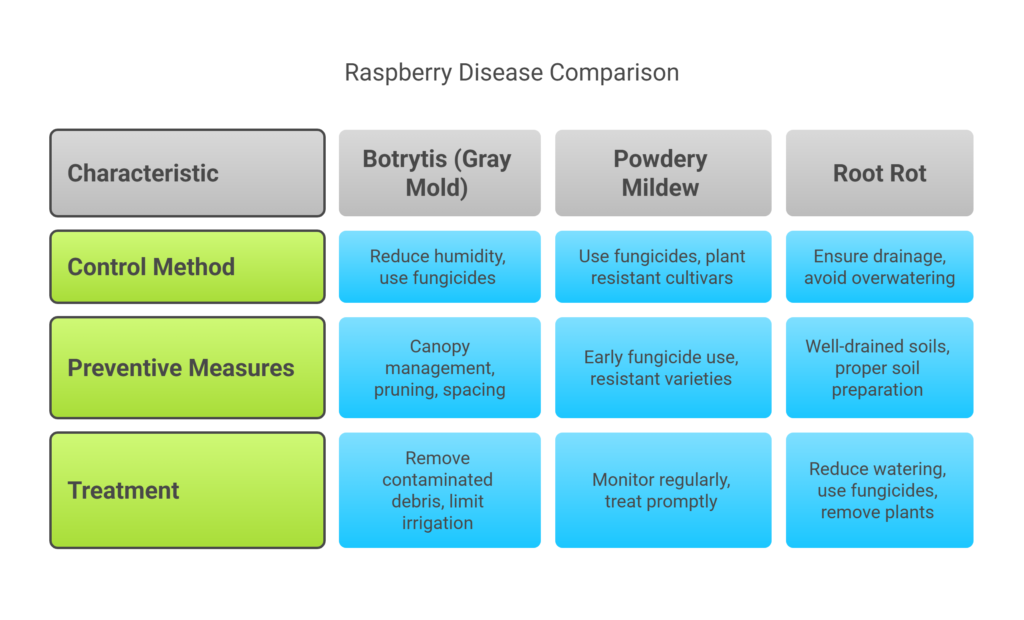
a). Botrytis (Gray Mold)
Botrytis (gray mold), a fungal disease that damages raspberry fruit and canes, can be managed by reducing humidity around plants through proper canopy management, pruning, and adequate spacing. Preventive fungicides, such as sulfur- or copper-based sprays, should be applied during flowering or under humid conditions. Prompt removal of contaminated plant debris helps prevent spore spread, while limiting overhead irrigation keeps foliage dry. Integrating cultural practices with targeted fungicide use effectively reduces outbreaks, preserves fruit quality, and extends post-harvest shelf life.
b). Powdery Mildew
By using sulfur-based fungicides early in the infection cycle or by planting disease-resistant cultivars (such ‘Polka’ or ‘Joan J’), raspberry leaves and stems can be protected against powdery mildew, a fungal disease that causes white, powdery growth. While resistant genotypes lessen the need for chemical interventions, resulting in healthier plants and longer-lasting yields, regular monitoring and prompt treatment stop spread. By combining these tactics with appropriate spacing and airflow optimization, their efficacy is increased, protecting the health of the plants and the quality of the fruit.
c). Root Rot
A fungal disease called root rot, which is brought on by standing water, can destroy raspberry bushes by rotting their roots and preventing them from growing. Raised beds or trenches enhance drainage in heavy soils, whereas prevention emphasizes growing in well-drained soils and avoiding excessive irrigation. To improve structure and aeration, make sure the soil is properly prepared with organic matter. Reduce watering, use fungicides indicated for soil-borne diseases, and remove seriously afflicted plants to stop the spread of root rot if it is detected. Irreversible damage is avoided, and root health is maintained by proactive maintenance.
Harvesting
Raspberries should be harvested when fully ripe, firm, and brightly colored, with careful hand-picking every 2–3 days during the season to avoid bruising and ensure peak freshness. Yields typically range from 2–4 tons per acre, influenced by cultivar selection, climate, and management practices. Post-harvest, berries must be cooled immediately to 0–4°C and sold within 1–2 days to preserve texture, flavor, and market value. Timely harvesting and proper handling minimize spoilage, maximize shelf life, and maintain the fruit’s visual appeal for commercial viability.
Cost of Investment per Acre for Raspberry
| S.N. | Categories | Summer Bearing (NRs) | Everbearing (NRs) |
| 1 | Land Preparation | 40,000 | 50,000 |
| 2 | Raspberry Saplings | 148,200 | 331,700 |
| 3 | Fertilizers and Manure | 100,000 | 150,000 |
| 4 | Irrigation System (Drip) | 150,000 | 200,000 |
| 5 | Labor Costs | 30,000 | 40,000 |
| 6 | Pest & Disease Control | 30,000 | 40,000 |
| 8 | Miscellaneous Costs | 25,000 | 35,000 |
| Total Initial Cost | 523,000 | 846,700 |
Annual Maintenance Cost of Raspberry Per Acre
Starting from the second year, the annual maintenance cost for raspberry cultivation ranges between NRs. 100,000 to 150,000 per acre, covering recurring expenses such as labor, pest control, fertilizer replenishment, irrigation upkeep, and minor equipment repairs. For simplified calculations, an average of NRs. 125,000 per acre is assumed, which accounts for routine operational needs and mitigates fluctuations due to seasonal variations or unexpected challenges.
This recurring cost is critical to sustaining yield quality and productivity, directly influencing long-term profitability by reducing net income annually until the end of the cultivation cycle. Farmers must budget for this expense to ensure consistent crop health and optimal returns, especially as yields increase significantly from the third year onward.
Income from One Acre Raspberry
| Year | Summer Bearing Yield | Everbearing Yield | Rate (NRs/kg) | Summer Income (NRs) | Everbearing Income (NRs) | ||
| 1st Year | 0 kg | 1,500 kg | 400 | 0 | 600,000 | ||
| 2nd Year | 1,000 kg | 2,500 kg | 400 | 400,000 | 1,000,000 | ||
| 3–10 Year | 2,000 kg | 3,000 kg | 400 | 800,000/yr | 1,200,000/yr | ||
| 11+ Year | 1,000 kg | 1,000 kg | 400 | 400,000/yr | 400,000 | ||
Analysis of Raspberry Farming Profit Per Acre
a). Summer Bearing Raspberry
The total income from summer-bearing raspberries over 10 years amounts to NRs. 6,800,000, with NRs. 400,000 generated in year 2 and NRs. 6,400,000 accumulated from years 3 to 10 (NRs. 800,000 annually for 8 years). The total costs include an initial investment of NRs. 523,000 and maintenance expenses of NRs. 1,125,000 over years 2 to 10 (NRs. 125,000 annually for 9 years), resulting in total costs of NRs. 1,648,000. This yields a net profit of NRs. 5,152,000 over the 10-year period.
b). Evergreen Bearing Raspberry
The total income from everbearing raspberries for over 10 years is NRs. 11,200,000, comprising NRs. 600,000 in year 1, NRs. 1,000,000 in year 2, and NRs. 9,600,000 from years 3 to 10 (NRs. 1,200,000 annually for 8 years). The total costs include an initial investment of NRs. 846,700 and maintenance expenses of NRs. 1,125,000 over years 2 to 10 (NRs. 125,000 annually for 9 years), amounting to NRs. 1,971,700. This results in a net profit of NRs. 9,228,300 over the 10-year period.
c). Break-Even Point
Summer bearing
The cumulative losses for summer-bearing raspberries until year 2 are NRs. 248,000, calculated as NRs. 523,000 (initial cost) + NRs. 125,000 (year 2 maintenance) – NRs. 400,000 (year 2 income). The break-even point is achieved by year 3 after generating a profit of NRs. 675,000 (NRs. 800,000 income – NRs. 125,000 maintenance).
Everbearing
The cumulative losses for everbearing raspberries until year 1 are NRs. 246,700, calculated as NRs. 846,700 (initial cost) – NRs. 600,000 (year 1 income). The break-even point is reached by year 2 after generating a profit of NRs. 875,000 (NRs. 1,000,000 income – NRs. 125,000 maintenance).
Recommendation
Everbearing raspberries require a 62% higher initial investment but begin generating income in year 1, achieving break-even in year 2, while summer-bearing raspberries start earning in year 2 and break even in year 3. Over 10 years, everbearing yields 79% higher profit (NRs. 9.23M vs. NRs. 5.15M). However, after year 10, both varieties produce 1,000 kg annually, reducing income to NRs. 400,000 per year. For quicker returns and a higher upfront investment, everbearing is preferable, while summer bearing is suited for those prioritizing lower initial costs and gradual income. Diversifying with both varieties can help balance cash flow and mitigate risks.

